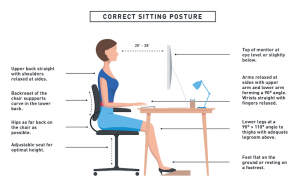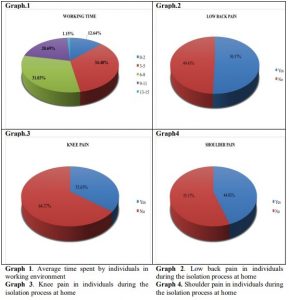“Hey, sit up straight!” “Stop slouching!” Growing up, I’m sure we have all been scolded by our parents at the dinner table for having poor posture, without realizing why it was such an issue. Even though comments like these tend to get on our nerves from time to time, we aren’t reminded of our posture for no reason.
Ever since lockdown was declared due to COVID-19, the majority of university students have slowly adapted to the routine of working from home, as we now spend an abundant amount of time in front of screens, and developing excessive sedentary behaviour. This increased exposure to digital device usage serves as hazardous beginning stages for the development of poor posture and health risks.
What Is Posture and What Does Good Posture Look Like?
Posture is based on the body’s positioning and alignment in conjunction with the force of gravity. Whenever we are sitting, standing or lying down, gravity plays a vital role in exerting force on our joints, ligaments and muscles.
To indicate good posture when sitting at a desk or your personal work environment, your chair should be adjusted appropriately so that your feet rest flat on the floor and knees bent naturally. If you spend an adequate amount of time sitting in front of a computer screen, your monitor should be positioned at eye level or slightly below eye level to decrease strain on the neck.

Demonstrates the requirements for achieving correct sitting posture
Photo by Sophia, Jack
Source: bestchairlist.com
Long-Term Health Risk Factors
While not everyone is fortunate enough to have a dedicated and ergonomically friendly workstation, this leaves many working from sofas, beds, and chairs with a lack of proper support. As a result, some of the most common yet vital long-term health factors are at risk.
A recent study analyzed the pain and disability situation of individuals working from home during the COVID-19 isolation process. It was discovered upon the 87 volunteers who were included in a digital media questionnaire which focused on the transition from working in offices, that 50.6% of individuals suffered from low back pain, 44.8% from shoulder pain, and 35.6% from knee pain. This demonstrates that postural stress is closely associated with poor workstation ergonomics.

Pie graph analysis of pain resulting from working at home during COVID-19 isolation
Photo by PEKYAVAS, Nihan
Source: https://dergipark.org.tr/en/pub/ijdshs/issue/56796/772675
The Influence of Posture on Daily Activities
Brian Betancourt, exercise physiologist and Dr.Jose Mena, interventional spine specialist, summarize the effects of poor posture in the neck from daily activities while elaborating on a unique piece of advice to combat poor posture.
Looking Forward
The COVID-19 pandemic has fundamentally changed the way we work as we slowly become more susceptible to health risks from developing poor sedentary posture. During this isolation process, it’s important that we consider our posture to avoid being negatively affected in areas of our body, over the course of heavy work sessions. This will ultimately allow us to freely engage and participate in meaningful activities in the long run.
– Gordon Wu

One response to “Your Posture Impacts More Than You Think”